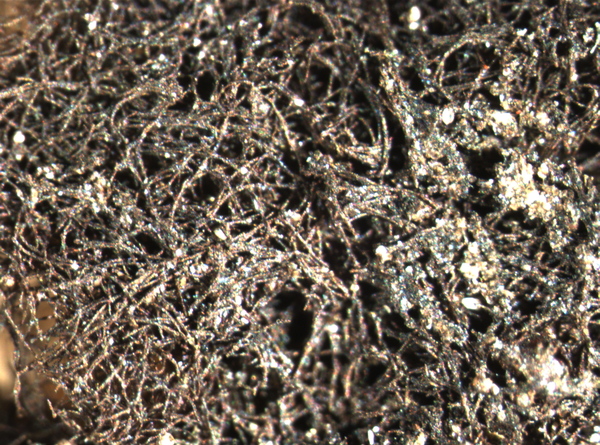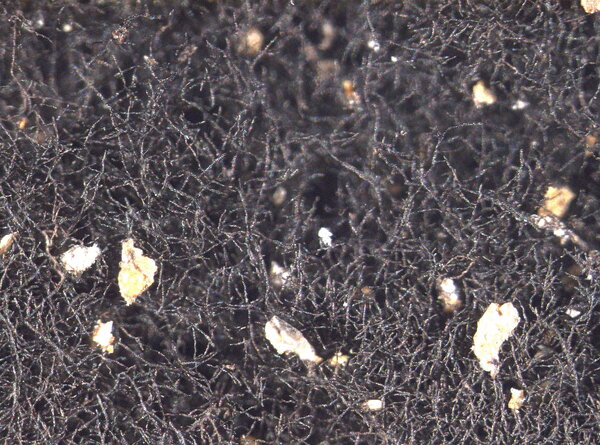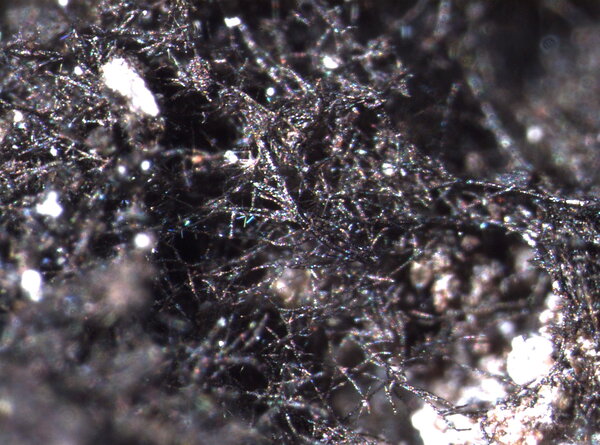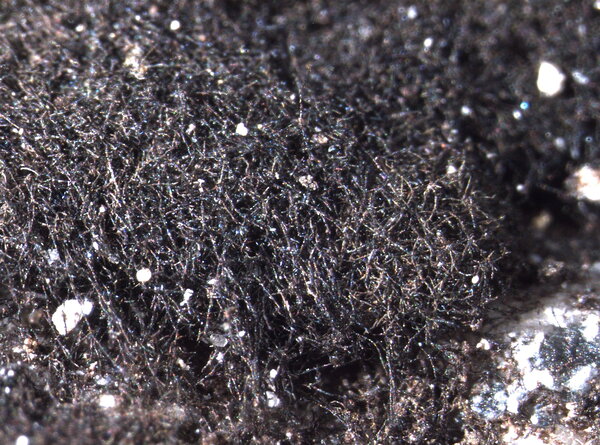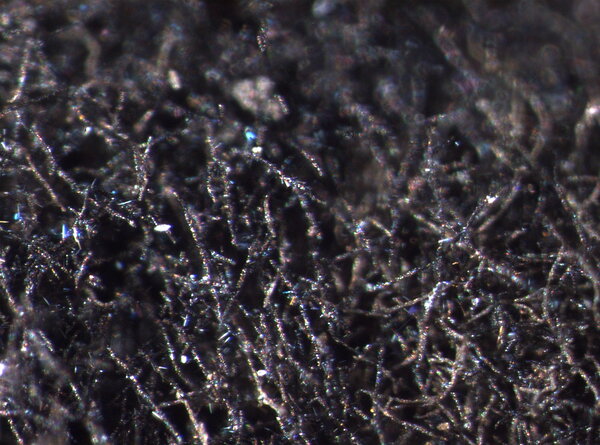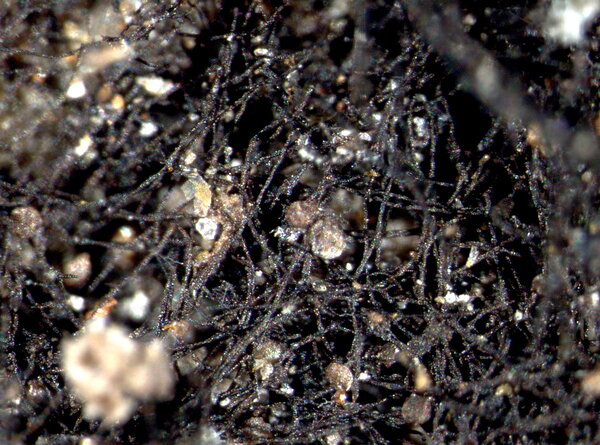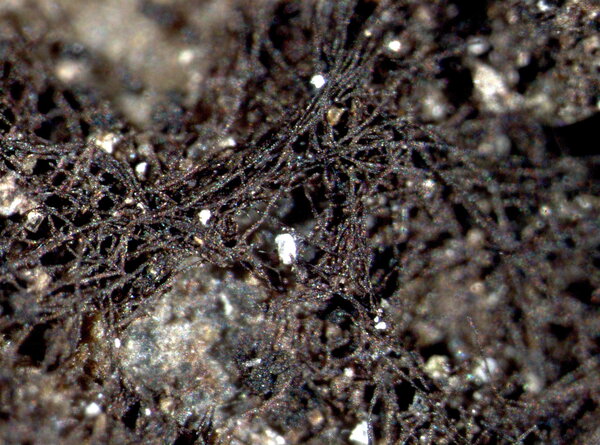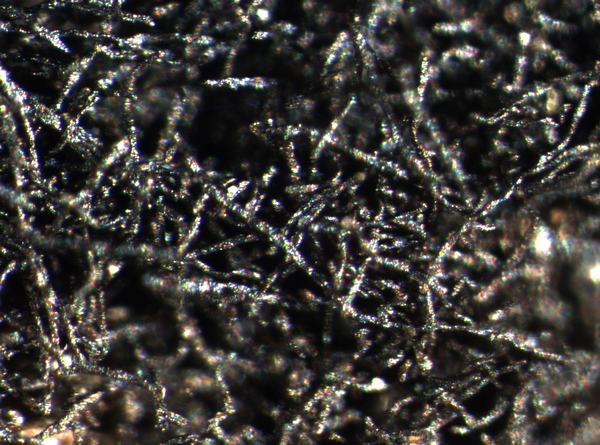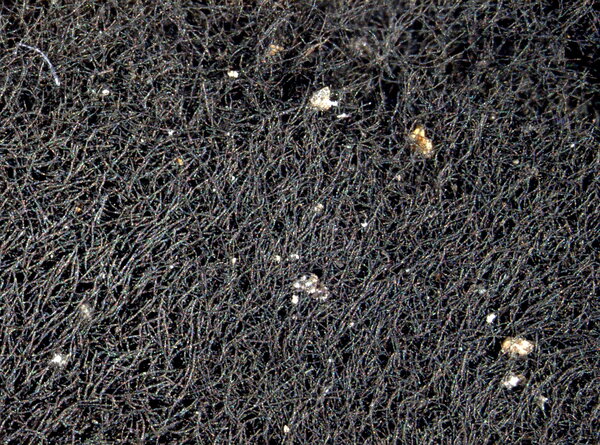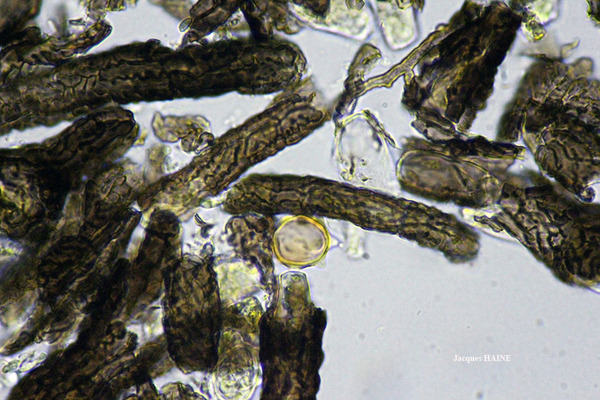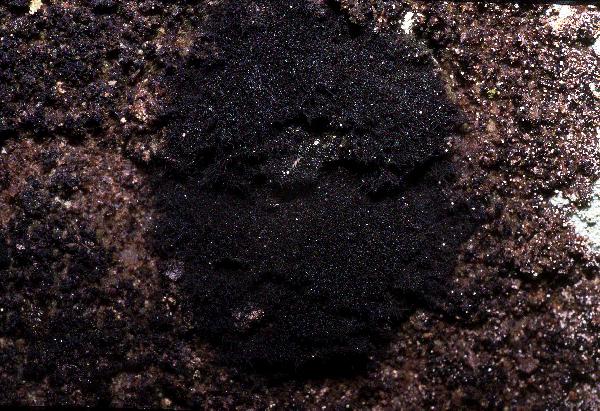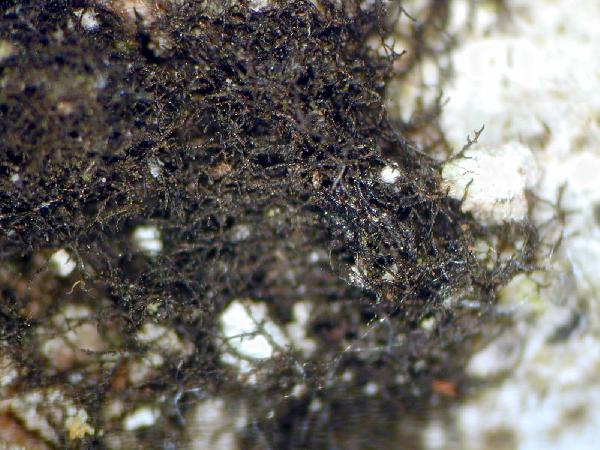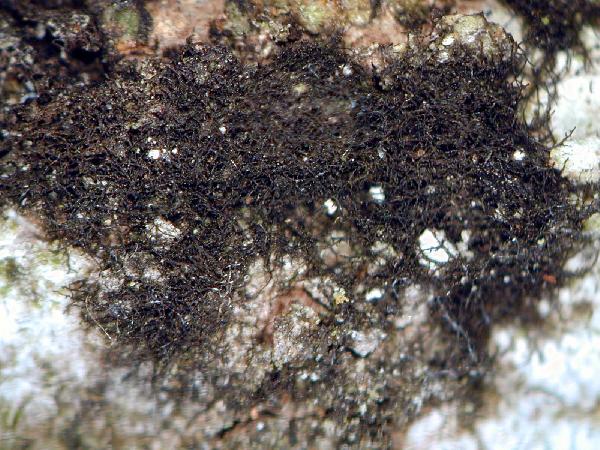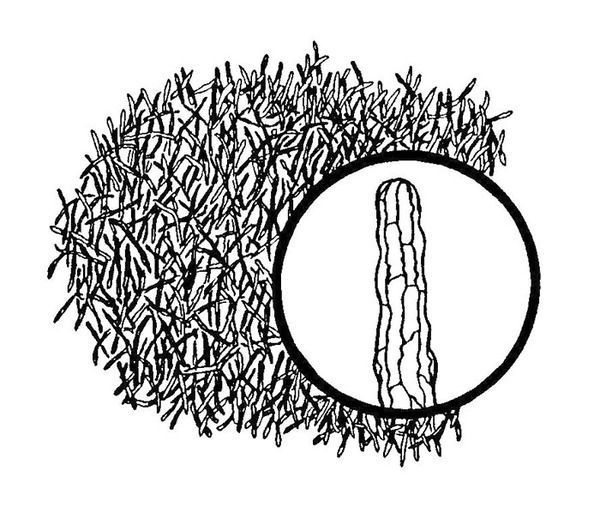Cystocoleus ebeneus (Dillwyn) Thwaites
Ann. Mag. Nat. Hist., ser. 2, 3: 241, 1849. Basionym: Conferva ebenea Dillwyn - Brit. Corferv.: tab. 101, 1809.
Synonyms: Coenogonium ebeneum (Dillwyn) A.L. Sm.; Coenogonium germanicum Glück; Cystocoleus niger auct. non (Huds.) Har.; Racodium ebeneum (Dillwyn) Fr.
Description: Thallus minutely filamentous, forming mats or small tufts on the rock, consisting of c. 10-13 µm thick, irregularly arranged, black, nodulose, sometimes shortly branched (at right angles) filaments. Filaments covered with dark-brown, tortuous, branched, brown-pigmented, short-celled hyphae with irregularly undulate, thick walls reacting I+ blue-black, forming a dense network closely surrounding and adhering to single filaments of Trentepohlia. Apothecia and pycnidia unknown. Photobiont trentepohlioid. Spot tests: all negative. Chemistry: without lichen substances.
Growth form: Crustose
Substrata: rocks
Photobiont: Trentepohlia
Reproductive strategy: mainly asexual, by thallus fragmentation
Most common in areas with a humid-warm climate (e.g. most of Tyrrenian Italy)
In underhangs rarely wetted by rain
Commonnes-rarity: (info)
Alpine belt: absent
Subalpine belt: extremely rare
Montane belt: very rare
Dry submediterranean belt: extremely rare
Humid submediterranean belt: very rare
Padanian area: absent
pH of the substrata:
1 2 3 4 5
Solar irradiation:
1 2 3 4 5
Aridity:
1 2 3 4 5
Eutrophication:
1 2 3 4 5
Poleotolerance:
0 1 2 3
Altitudinal distribution:
1 2 3 4 5 6
Rarity
absent
extremely rare
very rare
rare
rather rare
rather common
common
very common
extremely common
Loading data...
Occurrence data
Predictive map
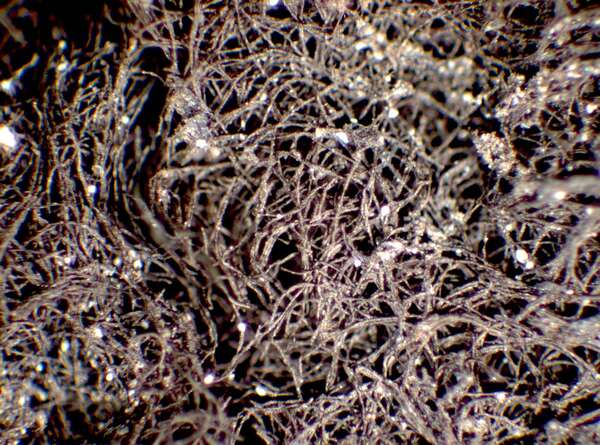
P.L. Nimis; Owner: Department of Life Sciences, University of Trieste
Herbarium: TSB (28586)
2001/11/23

P.L. Nimis; Owner: Department of Life Sciences, University of Trieste
Herbarium: TSB (34822)
2002/02/12
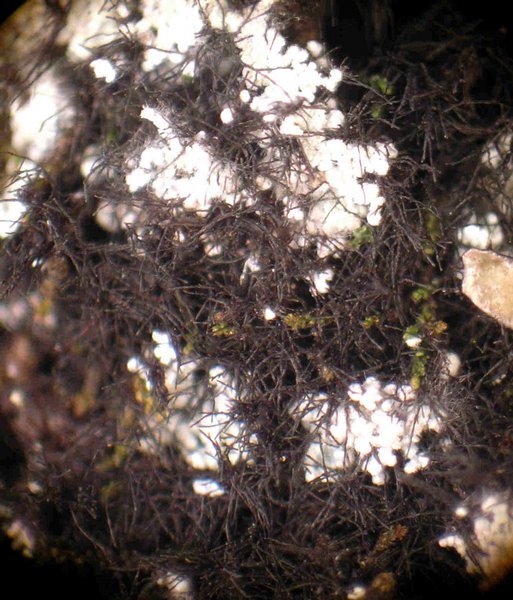
Curtis Randall Björk – CC BY-SA 4.0
British Columbia, Clearwater Valley Date: 2010-11-03 On siliceous boulder talus
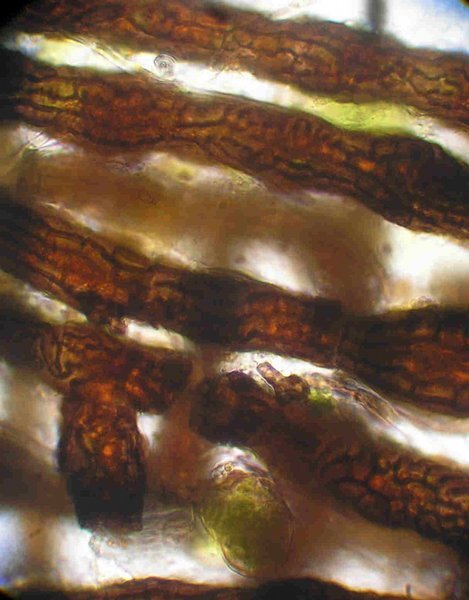
Curtis Randall Björk – CC BY-SA 4.0
British Columbia, Clearwater Valley Date: 2010-11-03 On siliceous boulder talus
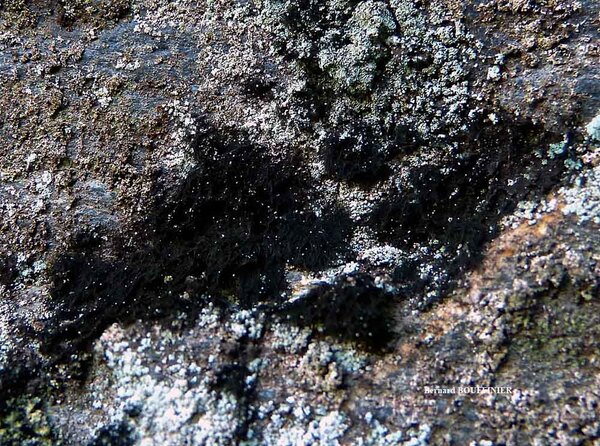
Bernard Bouffinier - Source: http://www.lichensmaritimes.org/index.php?task=fiche&lichen=602&lang=en
France, Roc'h Trédudon
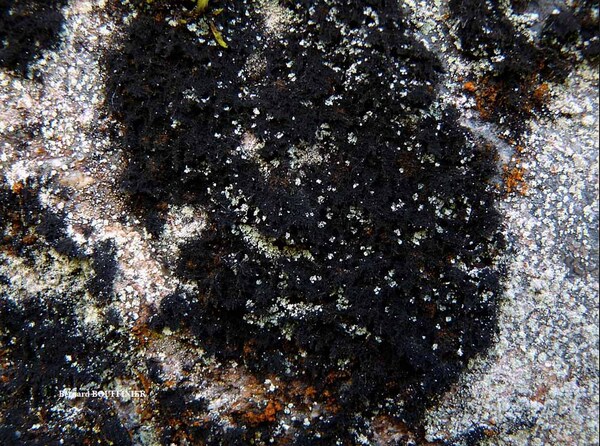
Bernard Bouffinier - Source: http://www.lichensmaritimes.org/index.php?task=fiche&lichen=602&lang=en
France, Roc'h Trédudon
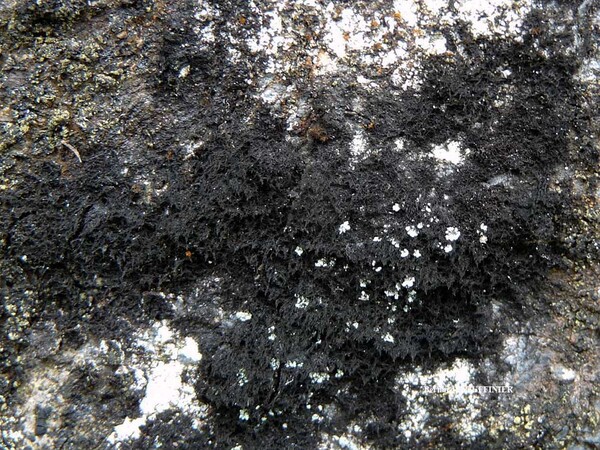
Bernard Bouffinier - Source: http://www.lichensmaritimes.org/index.php?task=fiche&lichen=602&lang=en
France, Roc'h Trédudon
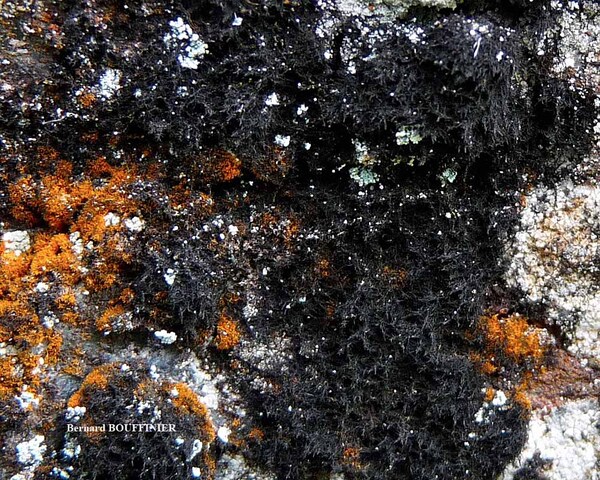
Bernard Bouffinier - Source: http://www.lichensmaritimes.org/index.php?task=fiche&lichen=602&lang=en
France, Roc'h Trédudon

Bernard Bouffinier - Source: http://www.lichensmaritimes.org/index.php?task=fiche&lichen=602&lang=en
France, Huelgoat
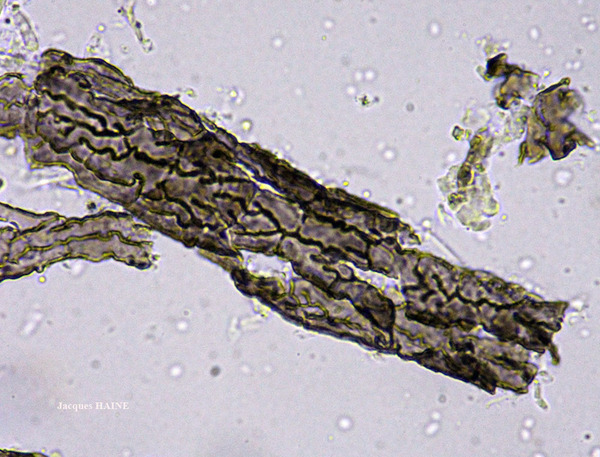
Jacques Haine - Source: http://www.lichensmaritimes.org/index.php?task=fiche&lichen=602&lang=en
France, Ardennes
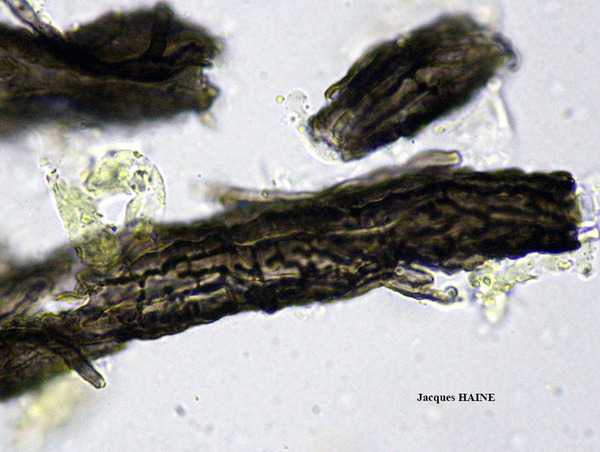
Jacques Haine - Source: http://www.lichensmaritimes.org/index.php?task=fiche&lichen=602&lang=en
France, Ardennes

Jacques Haine - Source: http://www.lichensmaritimes.org/index.php?task=fiche&lichen=602&lang=en
France, Ardennes
Growth form: Crustose
Substrata: rocks
Photobiont: Trentepohlia
Reproductive strategy: mainly asexual, by thallus fragmentation
Most common in areas with a humid-warm climate (e.g. most of Tyrrenian Italy)
In underhangs rarely wetted by rain
Commonnes-rarity: (info)
Alpine belt: absent
Subalpine belt: extremely rare
Montane belt: very rare
Dry submediterranean belt: extremely rare
Humid submediterranean belt: very rare
Padanian area: absent
pH of the substrata:
| 1 | 2 | 3 | 4 | 5 |
Solar irradiation:
| 1 | 2 | 3 | 4 | 5 |
Aridity:
| 1 | 2 | 3 | 4 | 5 |
Eutrophication:
| 1 | 2 | 3 | 4 | 5 |
Poleotolerance:
| 0 | 1 | 2 | 3 |
Altitudinal distribution:
| 1 | 2 | 3 | 4 | 5 | 6 |
Rarity
absent
extremely rare
very rare
rare
rather rare
rather common
common
very common
extremely common
Loading data...
Occurrence data
Predictive map

P.L. Nimis; Owner: Department of Life Sciences, University of Trieste
Herbarium: TSB (28586)
2001/11/23

P.L. Nimis; Owner: Department of Life Sciences, University of Trieste
Herbarium: TSB (34822)
2002/02/12

Curtis Randall Björk – CC BY-SA 4.0
British Columbia, Clearwater Valley Date: 2010-11-03 On siliceous boulder talus

Curtis Randall Björk – CC BY-SA 4.0
British Columbia, Clearwater Valley Date: 2010-11-03 On siliceous boulder talus

Bernard Bouffinier - Source: http://www.lichensmaritimes.org/index.php?task=fiche&lichen=602&lang=en
France, Roc'h Trédudon

Bernard Bouffinier - Source: http://www.lichensmaritimes.org/index.php?task=fiche&lichen=602&lang=en
France, Roc'h Trédudon

Bernard Bouffinier - Source: http://www.lichensmaritimes.org/index.php?task=fiche&lichen=602&lang=en
France, Roc'h Trédudon

Bernard Bouffinier - Source: http://www.lichensmaritimes.org/index.php?task=fiche&lichen=602&lang=en
France, Roc'h Trédudon

Bernard Bouffinier - Source: http://www.lichensmaritimes.org/index.php?task=fiche&lichen=602&lang=en
France, Huelgoat

Jacques Haine - Source: http://www.lichensmaritimes.org/index.php?task=fiche&lichen=602&lang=en
France, Ardennes

Jacques Haine - Source: http://www.lichensmaritimes.org/index.php?task=fiche&lichen=602&lang=en
France, Ardennes





